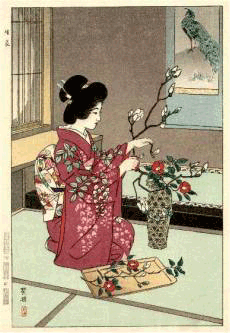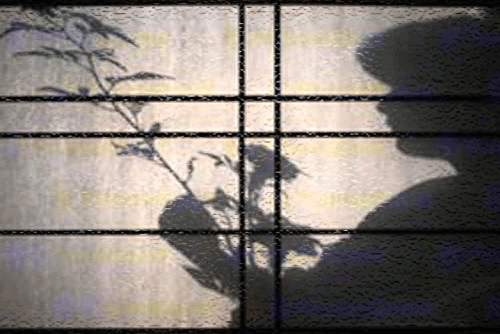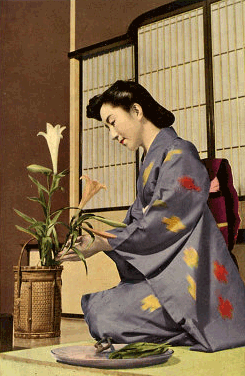Ikebana – A bit of History
Alain DELAYE

A name emerges here : that of the ambassador Ono no Imoko, who became the priest Senmu and who was the first in Japan to codify the floral art, preferring the Buddhist sobriety, and the classic rigour of the trinitarian principle that we still find today in many Japanese bouquets, to the Confucian exuberance. He specified in fact that the offerings of flowers to Buddha should be composed of three flowers : one tall and two shorter. We have there the origin of the first vertical arrangement, named tatebana, which gave later rikka and shôka. Nevertheless, Senmu also disposed the flowers in another way : piling them up in a dish or in a basket. This second arrangement formed the prototype of what will become moribana
Ike-no-bo (literally: the hut near the pool) was the little house where Senmu retired to exercise his Buddhist ministry and to diffuse the understanding of flowers. His descendants carried on his work and created the school, which bears this name.
From the XIIth century, the Buddhist rites began to be celebrated in private residences also. Bouquets migrated from the temples to houses and spread from the ceremonies to feasts. The codification went on and became more elaborated. The most ancient text in that respect – the Sendenshô – assembled rules of mixed origins, that the school Ikenobô gathered. It foresaw fifty-three arrangements for all circumstances in life (marriage, majority of a boy, depart of a warrior…)
Other text-books proposed rules : the Mon’ami Densho which explains how to lay out arrangements and objects in or around the alcove of tokonoma, the Senno Kuden, first manual of landscapes actually giving all the possible variations of a unique landscape : that of the legendary mount Meru of which the Buddhist texts speak and which symbolises the entire universe.
Throughout the techniques, a spirit expressed itself. It could be shin : strict, imposing, traditional, symmetrical, so : light, spontaneous, asymmetrical, unforeseen, or gyo : between shin and so. The history of Ikebana is marked by permanent oscillation between these two poles : formal classicism (shin) and liberty (so). The bouquet proceeds from a state of mind, which it wants to arouse in those who are contemplating it. An important notion appears here : that of fûryû, which implicates simplicity, discretion and love of natural beauty, without ostentation. Fûryû turns away from exhibition and manifests serenity. Zen fills an important role in the development of this spirit.

But this discreet power of suggestion, sought from the origin in the Japanese bouquet, is difficult to attain and to conserve. At the end of the XVIth century, Hideyoshi, lord and patron, paranoiac and æsthete, gave the masters of flowers at his service, imposing and grandiloquent means to express themselves.
That is how, on the occasion of a ceremony in honour of the great Buddha of Nara, the flower arrangements rose as high as thirteen meters. The master Sen no Rikyû, an intimate of Hideyoshi, fell in with this megalomania by making monumental rikka to decorate his palaces. Nevertheless this master reacted by creating the chabana (literally “flowers of tea”) a simple arrangement, animated by a spirit for which the Japanese use a very particular name : wabi. The wabi is the refinement in simplicity, rustic elegance, nobility without sophistication, beauty reduced, or rather brought back to its essential simplicity. One simple flower perfectly disposed in a discreet vase can express it.
One also attributes the origin of nageire to Sen no Rikyû. One day when he and Hideyoshi were resting in the garden, the latter asked him to compose a bouquet. Sen no Rikyû therefore cut some iris with his dagger, attached them to it and sent the whole lot into a bucket. The bystanders, tells the anecdote, went into ecstasies before the masterpiece. The nageire (literally : cast, thrown away) was born.
During the XVIIth century, a political mutation affected the evolution of Ikebana. This, like all the Japanese arts had up to then, come under the influence of Zen Buddhism which had developed since its introduction in the XIIth century. With the shôgunat of the Tokugawa and under its impulse, Confucianism supplanted Zen. The Tokugawa encouraged it as the philosophical foundation of their power, while at the same time they relegated the nobility to Kyôto and occupied it with cultural activities, which did not overshadow them.
Floral art entered the game of rivalries and court intrigues, and received thereby the official name of Ikebana. The shôgunat at first committed it to the care of a unique family, Ikenobô, but soon, competitors surged up and other schools saw the day. The shôgunat canalised them by establishing the hereditary transmission of the iemotos, still in force these days. This epoch was marked by a decrease in the values of intuition and spontaneity, which characterised the nageire in favour of a codification, more and more complex of the rikka. In 1673 Rikka arrangements of the Ikenobô school of Rokkaku-dô and his pupils was published, in 1683 the Encyclopaedia of Rikka came out, and in 1668 the Admitted styles of Rikka. Finally came the Images of Hundred Arrangements in vases for the four seasons, which says “if the rules are not observed, flowers cannot be considered as a valid decoration for the tokonoma.”
No great masters, a lot of rules, and the snobbery of a lazy aristocratic class trying valorise itself by sterile exhibitions, this is the harsh judgement one could make concerning the Ikebana of the XVIIth century. Nevertheless a new merchant class was in the throes of being born. It began to interest itself in floral art, and with it began a democratisation of its practice.
This democratisation took place in the XVIIIth century. It concerned social classes but also the sexes. Floral art, until then reserved to men, was learnt by women together with music and the tea ceremony. This brought about a simplification of the rules of rikka, a revival of nageire and the birth of new more popular style, mixing the characteristics of the two : shôka. This simple style, of three symmetric branches, was organised according to a trinitarian scheme.
On the XVIIIth century, the number of pupils practising Ikebana increased considerably, schools multiplied, flowers came into the houses and covered kimonos and folding screens as they had never done before. A reaction manifested itself against the snobbery of the aristocrats and the rigourless facility of the new wealthy classes.
 A group of creators who were seeking in Ikebana something else than a frivolous decorative activity brought a second wind. These people were well-read persons – bunjin – very sensitive to the models that Japan had inherited from China and wishing to remake ties in matters of art (poetry, painting, floral art…) with Chinese æsthetics. They set up a style drawing its inspiration from this : bunjin ike which broke away from excessive codification, seeking to recover spontaneity, naturalness, but also the refinement of Chinese art.
A group of creators who were seeking in Ikebana something else than a frivolous decorative activity brought a second wind. These people were well-read persons – bunjin – very sensitive to the models that Japan had inherited from China and wishing to remake ties in matters of art (poetry, painting, floral art…) with Chinese æsthetics. They set up a style drawing its inspiration from this : bunjin ike which broke away from excessive codification, seeking to recover spontaneity, naturalness, but also the refinement of Chinese art.
In 1854, the American commandant Perry destroyed the isolating bolt, which kept Japan, shut within its isles and opened it to commerce and to western culture. The political and artistic incidences of this event were innumerable. Concerning Ikebana, the arrival of new flowers inspired a master named Unshin Ohara who, in addition, intended restoring ancient traditional models such as landscape. Unshin Ohara founded his own school. Other creators, like Nishikawa, tried to implant more profoundly the new freedom and to renew with the spirit of wabi.
Towards 1920, a new wave appeared and a new freer style of floral arrangement : jiyubana. Refusing the original Buddhist reference and traditional codifications, the young revolutionaries Nakayama, Okubô, Shigemori… published in 1930, a manifesto entitled Proclamation of the New Style of floral Arrangement in which they intended to take some distance regarding the floral artists of the past. Then, their war cry was : “Liberate Ikebana from tokonoma !” From these tendencies, the Sogetsu School was born, founded by Sofû Teshigahara. Then, others schools appeared, with the result that in 1966, the Japanese Association of Ikebana regrouped more than hundred and thirty of them. But, from 1930, the three big schools, which dominate today the Japanese and worldwide landscape of Ikebana – Ikenobô, Ohara and Sôgetsu -, were in place.
This text is translated from the book of Alain Delaye : Les fleurs dans l’art et la vie (Éd. l’Originel, 5 passage de la Folie-Regnault 75011 Paris) .
To practice Ikebana in France, see : Centre Ikebana, 26 rue d’Armaillé, 75017 Paris, tel 01 45 74 21 28




